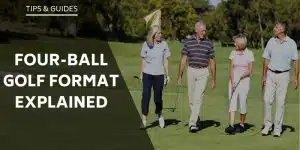One of the most important skills in golf is being able to hit the golf ball straight. It may also be one of the more difficult skills to achieve. Hitting the golf ball straight requires a golfer to be able to understand and execute all of the basic fundamentals within the game, which can be overwhelming.
Here’s a simple step-by-step plan regarding how to hit a golf ball straight:
- Spine tilted 30-degree forward
- Use consistent neutral grip
- Align toward target
- Downswing 2-3x faster than backswing
- Transfer weight from trail to lead foot
- Move arms in 1-piece on takeaway
- Point club at target at top
- Shift to lead side on transition from top
- Square clubface impact position
- Release with club towards target
But this is just a quick cheat sheet and to hit a ball straight in golf and you’ll want to understand and practice each element of these fundamentals. If you don’t know the details, you could hurt your swing more than help.
In this article I will touch on all of these step-by-step swing fundamentals to help you hit the ball and drive the ball straight every time (or at least pretty often!).
Understanding the Basics of the Golf Swing
Having a good understanding of the basics in golf is critical to good play. It is also an essential part of being able to hit the golf ball straight.
The starting point for anyone just getting going in golf should be the pre-swing fundamentals of Posture, Grip and Alignment. Ironically, these are also some of the same things that PGA and LPGA Tour Professionals go back to when their game needs a tune up.
Master Your Pre-Swing Fundamentals
Posture With 30-Degree Forward-Tilting Spine
Posture is a critical component to good ball striking. Essentially, the golf swing is a rotational movement of the body around a central point. That central point being your spine.
As you get set, your feet will generally be set shoulder width apart. When clubs get longer, as with the driver, you can get a little wider in your stance.
In regards to good posture, you will have a slight forward tilt of your spine, from your hips, of roughly 30 degrees. From there, your arms will hang straight down naturally from the shoulders.
For longer clubs, particularly with the driver, you will also want to create what is called secondary spine tilt. This is setting the spine back slightly, with the lead hip towards the target. This improves launch conditions with less lofted clubs.
The final component to good posture is a slight flex of the knees.
Consistent Neutral Grip
Having a good consistent grip on the club is probably one of the most important fundamentals. The body’s only connection to the club is through the grip. Your hands control the clubface.
The ability to hit the ball straight requires both hands to work together and not independently of each other. A neutral grip is one where the “V’s” (created by the pointer finger and thumb) are pointing towards the trail shoulder. A more neutral grip, as compared to a strong or weak grip, is more conducive to hitting straight shots.
Proper grip pressure is also important. You must grip the club with equal pressure. Not too tight. Not too weak.
Alignment With Your Target
All of the pre-swing fundamentals are important. But none may be any more important than good alignment.
Growing up, I was introduced to the game by my father. He taught me to think of Alignment as being like a set of railroad tracks. This concept was something I heard again, several times in fact, from my golf coaches and mentors as I was coming up.
Constantly, when I ask students to pick a target and line up to it, I find them setting up too far right of it (for right-handed golfers). The first instinct seems to be to line the body up to the target first rather than the clubface. Besides the obvious, of missing shots to the right, setting up right of the target will also lead to other issues such as a poor swing path.
The Right Track (For Right-Handed Golfers)
The right track represents an imaginary straight line that runs from behind the ball, through the ball and on through to the intended target.
The Left Track (For Right-Handed Golfers)
The Left track is a little bit more complex. This track should be parallel to the left (for right-handed golfers) of your right track, or target line. This track will include your toe line, and then, stacked on top of that, your knee line, hip line, and shoulder line.
Proper alignment sets the body up to be able to hit the ball where you want it to go.
Read more: How To Drive A Golf Ball
Master Your In-Swing Fundamentals
Once the pre-swing fundamentals are in good shape, you are well on your way to finding success. You are also on a good path towards being able to hit the ball straight.
As you start to swing the club, there are a handful of fundamentals to be aware of in order to hit the ball straight.
Balance and Tempo: Downswing is 2-3x Faster Than Backswing
Being able to maintain good balance throughout the swing is key in hitting the ball straight. The same can be said with tempo. The two really go hand and hand.
Tempo is the ratio of your backswing time to your downswing time. Blast Motion Golf is a great training aid which focuses on tempo. According to their research, golf professionals maintain a tempo of anywhere from a 2:1 to 3:1, depending on whether they are using a putter or on up to a driver. Those ratios mean that the downswing is 2 to 3 times faster than the backswing.
When tempo is good, balance can be maintained. This often limits unnecessary movements which can rob a swing of power and accuracy.
Weight Transfer and Pressure Shift From Trail To Lead Foot
An essential aspect of making good athletic moves in many sports is the ability to move from one side of your body to the other correctly. This is especially true in golf.
When you make a golf swing you are attempting to create torque or slowly build up power as you go back. As you come down from the top you are looking to use that built up torque to powerfully move through the ball and on to your finish.
The term weight transfer often gets interlaced with the term pressure shift. These are not actually one in the same.
According to Merriam-Webster, the following are the definitions of the terms Weight and Pressure.
Pressure: The weight or force that is produced when something presses or pushes against something else.
Weight: A body’s relative mass, or the quantity of matter contained by it. The heaviness of a person or thing.
In general, we want our weight to stay centered in our stance throughout the swing. Our pressure will move to a minimum of 60% into our trail foot in the backswing. Then, at the beginning of our transition from the top, the pressure will move to 70% or more into our lead foot.
Read more: How To Hit A Drive Consistently
Move Arms in One Piece on Takeaway
Taking the club back from the address position is the start of what makes up the swinging motion in golf. And it all happens pretty fast from there. The average swing only takes 1.2 seconds from start to finish.
With that in mind, it is pretty important to start the swing off correctly with a proper takeaway. But what exactly does that consist of?
Your arms and the shaft of the club should move back together, in one piece as you start back. The clubface should remain square to the ball and the target line. At the halfway back point the shaft should be parallel to your body and target lines.
Point Club at Target at the Top of the Swing
The ideal, textbook position at the top of the swing is to have the club pointing to the target and parallel to the ground. With that, the clubface should be in line with a flat lead wrist. That ensures a square clubface which is critical to hitting straight shots.
Even more important is to have your body as fully coiled up as you can. That is probably more important than your ability to get the club pointing to the target and parallel to the ground.
You will see many of the best players in the world not getting the club into that “ideal” position at the top. Yet they have indeed fully turned their shoulders and are in a powerful position.
If hitting straight shots is the goal, I would suggest being most concerned with making a good turn and having a square clubface at the top.
Shift to Lead Side on Transition Down From the Top
After a golfer gets properly loaded at the top, it then becomes go time! This is the moment in the swing where you will be unleashing all of the potential energy you have built up in the backswing, down and through the golf ball.
The first move in the transition down from the top is a pressure shift into your lead side. At the same time, you are looking to uncoil the body, hips first, then the upper body, while keeping your weight centered.
The club itself will ideally be playing catch up right behind the uncoiling of the body. The club should also have a very slight shallowing out on its path down to impact. This will allow you to swing more from the inside on your way to impact.
Again, one of the most important things in hitting the ball straight is control of the clubface. If you are set properly at the top, in terms of the clubface, you should be good on the way down.
Square Clubface Impact Position
While all parts of the swing are important to your overall result, none may be more important to hitting a straight shot than a good impact position. But what does this mean exactly?
The most obvious part of having a good impact position would be a square clubface coming into the ball. The clubface should be facing towards your intended target.
In addition to that, you want to also have the feeling of the hips turning towards the target as well at impact. That will be quickly followed by your chest facing the target.
To be in a powerful position at impact, the hands and shaft should be leading. Meaning, they should be in front of the clubhead.
Release With Arms, Hands, & Club Extending Towards Target
If all things are done correctly, preceding the point of releasing the club post impact, this should happen naturally. That would actually be my best advice regarding a proper release. Focusing on everything leading up to this point and it should happen naturally.
Post impact, and as the body finishes uncoiling, you want the arms, hands and club to extend out towards the target. The forearms should naturally be rotating at this point and the clubface (for right handers) should be pointing left.
Balanced Finish
You will likely start seeing a pattern here. As we move through the various parts of the swing, everything should be a result of the position prior. Meaning, with the swing taking only 1.2 seconds on average, this all happens very fast. And each point through the swing will have a direct response to the next.
A balanced finish will be the result of a swing in good tempo. A balanced finish will be a result of the proper sequence of the coiling up of the body, and the uncoiling from the top, through impact and on to the finish.
Hitting the golf ball straight, much like having a balanced finish, is the result of all aspects of the swing working together.
Clubface Control
The last area to consider when looking to hit the golf ball straight is clubface control. This is not actually a part or component of the swing itself. It is more a desirable result that comes from doing things correctly throughout the swing.
Above we looked at all of the pre-swing and in swing fundamentals required for being able to hit crisp and straight golf shots. None is any less or more important than another when it comes to playing good golf.
However, as far as control of your clubface is concerned, there are some key areas. The following are areas to consider when you are struggling with clubface control.
- Rolling the face open on the takeaway- It is very common to see golfers rolling the hands over and opening the clubface as the start back. Practice keeping the clubface square to the ball as you start your takeaway.
- Cupping or bowing the lead wrist at the top- The position of the clubface at the top of the swing is critical. The goal is to try and keep the clubface parallel to a flat lead wrist position at the top.
- Not squaring the face up at impact- A very common problem for golfers is coming into the ball at impact with a face too open or closed. The following video is a great drill to help with this.
Great Training Aids to Help You Hit the Ball Straight
The following are some great training aids to help you train your swing for hitting straighter shots. These are all items I use myself with students.
Eyeline Golf Speed Trap 2.0
Hackmotion Golf
Divot Board
Straight Hitting Golf Balls
In Summary
Many golfers strive to hit the golf ball straight. This may indeed be one of the more difficult things to do in the game. Many golfers have a preference of a shot shape they choose to hit. Some like to fade the ball and others like to draw it.
No matter your preference, having the ability to hit it straight, right to left, or left to right, all comes down to having solid fundamentals.
The biggest part of that may lie in being able to control your clubface throughout the swing. And especially at impact.
Read more: How To Hit A Low Golf Shot
FAQ’s
Why Is It So Hard To Hit a Golf Ball Straight?
Hitting the golf ball straight is very difficult. The reason for this is simple. Everything that needs to happen within a golf swing, at the same time, and all within 1.3 seconds is a lot.
It takes a great deal of practice and time to accomplish this. It can indeed be done and repeated over and over, but it takes commitment.
Do Harder Golf Balls Go Straighter?
Golf balls that are harder do indeed tend to go a little bit straighter. They also tend to go a little bit further as well. Because of the way they are constructed, the ball spins less. This is why they tend to go straighter and further.
The reality of this however is the reduction of sidespin is minimal. So is the increase in distance.
Read more: The Different Types of Golf Shots
Brendon is Class A PGA Professional and founded Little Linksters, LLC, and its nonprofit arm, the Little Linksters Association for Junior Golf Development. He won 25+ prestigious industry honors, including the 2017 PGA National Youth Player Development Award. He graduated from the PGA of America Management Program and has a handicap index of 7.8.
He has played golf for over 40 years and currently plays twice a month at the Eagle Dunes Golf Club near Sorrento, Florida. He loves Srixon clubs and plays a ZX5 driver with Z 585 irons. He's written over 60 articles on GolfSpan and specializes in sharing tips to improve your golf game. You can connect with Brendon at LinkedIn, X, IG, FB, his website, or BrendonElliott@pga.com.
- Best score: 69
- Favorite driver: Srixon ZX5
- Favorite ball: Srixon Z Star
- Favorite food at the turn: Turkey and cheese on white









